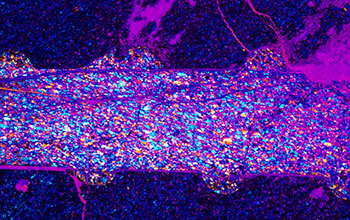Multimedia Gallery
Research may explain earthquakes in subduction zones
The mineral lawsonite undergoes brittle failure at high temperature and pressure, as evidenced by the cracks seen in this image. That brittleness could trigger earthquakes in subduction zones where lawsonite is present.
More about this image
A study by Brown University shows strong evidence that water squeezed out of a mineral called lawsonite could be a trigger for earthquakes that occur deep beneath the Earth’s surface in subduction zones, regions where one tectonic plate slides beneath another.
Subduction zones are some of the most seismically active areas on Earth. Earthquakes in these spots that occur close to the surface can be devastating, like the one that struck Japan in 2011 triggering the Fukushima nuclear disaster. But quakes also occur commonly in the subducting crust as it pushes deep below the surface at depths between 70 and 300 kilometers. These quakes, known as intermediate depth earthquakes, tend to be less damaging, but can still rattle buildings.
Intermediate depth quakes have long been something of a mystery to geologists. "They’re enigmatic because the pressures are so high at that depth that the normal process of frictional sliding associated with earthquakes is inhibited," said Greg Hirth, professor of Earth, environmental and planetary sciences at Brown. "The forces required to get things to slip just aren’t there."
Now, research in the lab by Hirth and postdoctoral researcher Keishi Okazaki has found that as water escapes from lawsonite at high temperatures and pressures, the mineral becomes prone to the kind of brittle failure required to trigger an earthquake.
"Keishi's experiments were basically the first tests at conditions appropriate for where these earthquakes actually happen in the Earth," Hirth said. "They’re really the first to show strong evidence for this dehydration embrittlement."
This research was supported by the National Science Foundation (grants OCE 10-49582 and EAR 13-15784).
To learn more about this research, see the NSF News From the Field story Research may explain mysterious deep earthquakes in subduction zones. (Date image taken: 2016; date originally posted to NSF Multimedia Gallery: Jan. 10, 2017)
Credit: Hirth Lab/Brown University
Images and other media in the National Science Foundation Multimedia Gallery are available for use in print and electronic material by NSF employees, members of the media, university staff, teachers and the general public. All media in the gallery are intended for personal, educational and nonprofit/non-commercial use only.
Images credited to the National Science Foundation, a federal agency, are in the public domain. The images were created by employees of the United States Government as part of their official duties or prepared by contractors as "works for hire" for NSF. You may freely use NSF-credited images and, at your discretion, credit NSF with a "Courtesy: National Science Foundation" notation.
Additional information about general usage can be found in Conditions.
Also Available:
Download the high-resolution JPG version of the image. (1.7 MB)
Use your mouse to right-click (Mac users may need to Ctrl-click) the link above and choose the option that will save the file or target to your computer.

